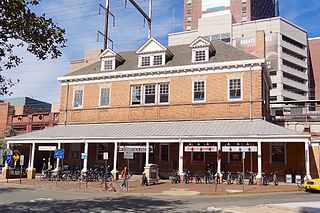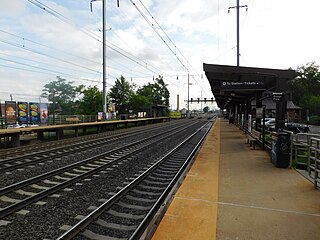
New Jersey Transit Corporation, branded as NJ Transit or NJTransit and often shortened to NJT, is a state-owned public transportation system that serves the U.S. state of New Jersey and portions of the states of New York and Pennsylvania. It operates bus, light rail, and commuter rail services throughout the state, connecting to major commercial and employment centers both within the state and in its two adjacent major cities, New York City and Philadelphia. In 2023, the system had a ridership of 209,259,800.

The River Line is a hybrid rail line in southern New Jersey that connects the cities of Camden and Trenton, New Jersey's capital. It is so named because its route between the two cities is parallel to the Delaware River.

The Northeast Corridor Line is a commuter rail service operated by NJ Transit between the Trenton Transit Center and New York Penn Station on Amtrak's Northeast Corridor in the United States. The service is the successor to Pennsylvania Railroad commuter trains between Trenton and New York, and is NJ Transit's busiest commuter rail service. After arrival at New York Penn Station, some trains load passengers and return to New Jersey, while others continue east to Sunnyside Yard for storage. Most servicing is done at the Morrisville Yard, at the west end of the line.

The Main Line is a commuter rail line owned and operated by New Jersey Transit running from Suffern, New York to Hoboken, New Jersey, in the United States. It runs daily commuter service and was once the north–south main line of the Erie Railroad. It is colored yellow on NJ Transit system maps, and its symbol is a water wheel.

Newark Penn Station is an intermodal passenger station in Newark, New Jersey. One of the New York metropolitan area's major transportation hubs, Newark Penn Station is served by multiple rail and bus carriers, making it the seventh busiest rail station in the United States, and the fourth busiest in the New York City metropolitan area.

NJ Transit Rail Operations is the rail division of NJ Transit. It operates commuter rail service in New Jersey, with most service centered on transportation to and from New York City, Hoboken, and Newark. NJ Transit also operates rail service in Orange and Rockland counties in New York under contract to Metro-North Railroad. The commuter rail lines saw 57,179,000 riders in 2023, making it the third-busiest commuter railroad in North America and the longest commuter rail system in North America by route length.

Princeton Junction station is a railroad station in Princeton Junction, New Jersey, located in West Windsor Township. It serves NJ Transit (NJT) and Amtrak on the Northeast Corridor (NEC), and NJ Transit on the Princeton Branch.

The Raritan Valley Line is a commuter rail service operated by New Jersey Transit (NJT) which serves passengers in municipalities in Union, Somerset, Middlesex, Essex and Hunterdon counties in the Raritan Valley region in central New Jersey, United States. The line's most frequent western terminus is Raritan station in Raritan. Some weekday trains continue farther west and terminate at the High Bridge station, located in High Bridge. Most eastbound trains terminate in Newark; passengers are able to transfer to NJ Transit using a combined ticket or PATH and Amtrak to New York City. A limited number of weekday trains continue directly to New York.

The Atlantic City Line (ACL) is a commuter rail line operated by NJ Transit (NJT) in the United States between Philadelphia, Pennsylvania and Atlantic City, New Jersey, operating along the corridor of the White Horse Pike. It runs over trackage that was controlled by both the Pennsylvania Railroad (PRR) and the Pennsylvania-Reading Seashore Lines. It shares trackage with SEPTA and Amtrak on the Northeast Corridor (NEC) until it crosses the Delaware River on Conrails Delair Bridge into New Jersey.

Trenton Transit Center is the main passenger train station in Trenton, New Jersey. It is the southernmost stop in New Jersey on the Northeast Corridor. It is the terminus for NJ Transit trains to and from New York City and SEPTA Trenton Line Regional Rail trains to and from Philadelphia, Pennsylvania, and an intermediate station for Amtrak trains traveling between the two cities along the Northeast Corridor.

The Millstone and New Brunswick Railroad (M&NB) was chartered in the mid-19th century as a seven-mile long branch line from New Brunswick, New Jersey to East Millstone, New Jersey. Construction was completed and the line began operation on December 19, 1854. In 1871, under the order of the company's president Martin Howell, the M&NB signed a 999-year lease with the United Jersey Railroad Company, which would later become part of the Pennsylvania Railroad (PRR) known as the "Millstone Branch." In 1915, the company was dissolved and became part of the United Jersey Railroad Company.

Rahway station is an NJ Transit train station in Rahway, New Jersey that is located 20.7 miles southwest of New York Penn Station, with service on the Northeast Corridor and North Jersey Coast lines.

New Brunswick is an active commuter railroad train station in the city of New Brunswick, Middlesex County, New Jersey, United States. The station services trains of New Jersey Transit's Northeast Corridor Line and Amtrak's Keystone Service and Northeast Regional. For New Jersey Transit trains, the next station to the southwest is Jersey Avenue, while the next station to the northeast is Edison. For Amtrak services, the next station southwest is Princeton Junction, the next station to the northeast is Metropark. The station consists of two handicap-accessible side platforms surrounding the four tracks.

North Elizabeth station is a commuter railroad station in the city of Elizabeth, Union County, New Jersey, United States. Located at the North Avenue bridge crossing in Elizabeth, the station serves trains of NJ Transit's Northeast Corridor and North Jersey Coast Lines. North Elizabeth station features two high-level platforms for handicap accessibility under the Americans with Disabilities Act of 1990.

Edison is a commuter railroad station in the Stelton section of Edison Township, Middlesex County, New Jersey, United States. Located at the intersection of Plainfield Avenue and Central Avenue, the station is served by New Jersey Transit's Northeast Corridor Line. Amtrak trains cross through but bypass the station. Edison station contains two side platforms, both high-level for handicap accessibility under the Americans with Disabilities Act of 1990 (accessible). The next station north, towards New York Penn Station is Metuchen while the next station south, with service towards Jersey Avenue station in New Brunswick and Trenton Transit Center is New Brunswick.

The Passaic–Bergen–Hudson Transit Project is a project under study by NJ Transit to reintroduce passenger service on a portion of the New York, Susquehanna and Western Railway (NYSW) right-of-way (ROW) in Passaic, Bergen and Hudson counties using newly built, FRA-compliant diesel multiple unit rail cars. Plans call for service to run from Hawthorne south through Paterson, east to Hackensack and then southeast to North Bergen, where it would join the Hudson-Bergen Light Rail (HBLR).
The Morrisville Yard is an American rail yard that is used by New Jersey Transit rail operations for trains on its Northeast Corridor Line. It is located roughly two miles west of the New Jersey state capital, Trenton, in Morrisville, Pennsylvania, and is accessible via the Morrisville-Trenton Railroad Bridge on the Delaware River.
North Brunswick is a proposed railroad station along the Northeast Corridor (NEC) in North Brunswick, New Jersey, that will be built by New Jersey Transit Rail Operations (NJT) to serve its Northeast Corridor Line. Approved in 2013, it was planned to open in 2018 and projected to cost $30 million. It is one of several projects along the "New Jersey Speedway" section of the NEC.

County Yard is a rail yard complex comprising Adams Yard, Delco Lead, and the eponymous County Yard along the Northeast Corridor (NEC). The complex straddles the New Brunswick and North Brunswick border in Central New Jersey.
69th Street is a proposed interchange station in North Bergen in Hudson County, New Jersey. It would serve passengers on two lines under consideration by NJ Transit, the Passaic–Bergen–Hudson Transit Project and the Northern Branch Corridor Project, the latter of which is an extension of the Hudson–Bergen Light Rail. The station would located at-grade west the North Bergen Yard and Tonnelle Avenue.



















